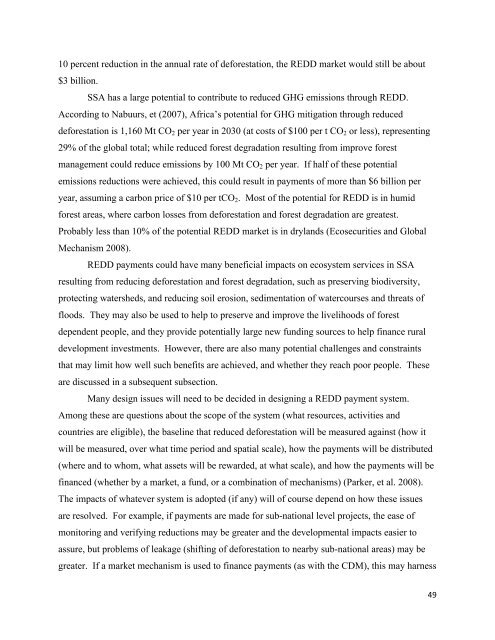The Role of Sustainable Land Management for Climate ... - CAADP
The Role of Sustainable Land Management for Climate ... - CAADP
The Role of Sustainable Land Management for Climate ... - CAADP
You also want an ePaper? Increase the reach of your titles
YUMPU automatically turns print PDFs into web optimized ePapers that Google loves.
!<br />
10 percent reduction in the annual rate <strong>of</strong> de<strong>for</strong>estation, the REDD market would still be about<br />
$3 billion.<br />
SSA has a large potential to contribute to reduced GHG emissions through REDD.<br />
According to Nabuurs, et (2007), Africa’s potential <strong>for</strong> GHG mitigation through reduced<br />
de<strong>for</strong>estation is 1,160 Mt CO 2 per year in 2030 (at costs <strong>of</strong> $100 per t CO 2 or less), representing<br />
29% <strong>of</strong> the global total; while reduced <strong>for</strong>est degradation resulting from improve <strong>for</strong>est<br />
management could reduce emissions by 100 Mt CO 2 per year. If half <strong>of</strong> these potential<br />
emissions reductions were achieved, this could result in payments <strong>of</strong> more than $6 billion per<br />
year, assuming a carbon price <strong>of</strong> $10 per tCO 2 . Most <strong>of</strong> the potential <strong>for</strong> REDD is in humid<br />
<strong>for</strong>est areas, where carbon losses from de<strong>for</strong>estation and <strong>for</strong>est degradation are greatest.<br />
Probably less than 10% <strong>of</strong> the potential REDD market is in drylands (Ecosecurities and Global<br />
Mechanism 2008).<br />
REDD payments could have many beneficial impacts on ecosystem services in SSA<br />
resulting from reducing de<strong>for</strong>estation and <strong>for</strong>est degradation, such as preserving biodiversity,<br />
protecting watersheds, and reducing soil erosion, sedimentation <strong>of</strong> watercourses and threats <strong>of</strong><br />
floods. <strong>The</strong>y may also be used to help to preserve and improve the livelihoods <strong>of</strong> <strong>for</strong>est<br />
dependent people, and they provide potentially large new funding sources to help finance rural<br />
development investments. However, there are also many potential challenges and constraints<br />
that may limit how well such benefits are achieved, and whether they reach poor people. <strong>The</strong>se<br />
are discussed in a subsequent subsection.<br />
Many design issues will need to be decided in designing a REDD payment system.<br />
Among these are questions about the scope <strong>of</strong> the system (what resources, activities and<br />
countries are eligible), the baseline that reduced de<strong>for</strong>estation will be measured against (how it<br />
will be measured, over what time period and spatial scale), how the payments will be distributed<br />
(where and to whom, what assets will be rewarded, at what scale), and how the payments will be<br />
financed (whether by a market, a fund, or a combination <strong>of</strong> mechanisms) (Parker, et al. 2008).<br />
<strong>The</strong> impacts <strong>of</strong> whatever system is adopted (if any) will <strong>of</strong> course depend on how these issues<br />
are resolved. For example, if payments are made <strong>for</strong> sub-national level projects, the ease <strong>of</strong><br />
monitoring and verifying reductions may be greater and the developmental impacts easier to<br />
assure, but problems <strong>of</strong> leakage (shifting <strong>of</strong> de<strong>for</strong>estation to nearby sub-national areas) may be<br />
greater. If a market mechanism is used to finance payments (as with the CDM), this may harness<br />
!<br />
',!

















